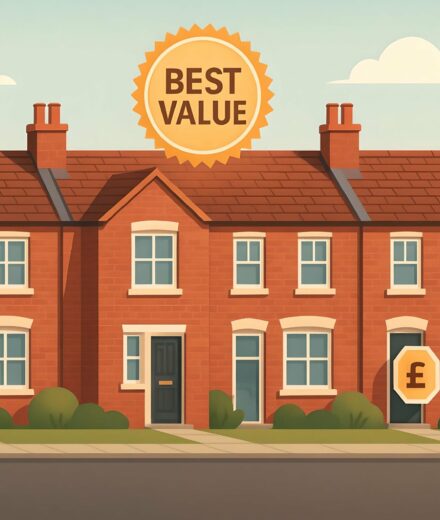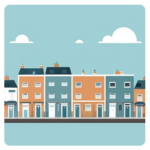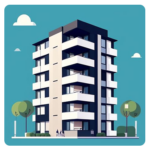

You won’t find any hot takes here – just house prices that have been quietly getting on with things. Swindon’s market, at its most revealing.
You’ll find everything in one spot – Swindon’s prices, patterns, and progress, all set out in a way that actually helps.
House Prices > Swindon
| Year | Average Price | Transactions |
|---|---|---|
| 2025 (proj.) | £302,700 | 4,756 |
| 2024 | £295,100 | 3,520 |
| 2023 | £294,300 | 4,227 |
| 2022 | £295,000 | 5,025 |
| 2021 | £275,100 | 6,109 |
| 2020 | £261,800 | 3,993 |
| 2019 | £254,700 | 4,926 |
| 2018 | £254,100 | 5,491 |
Property prices in Swindon have moved in a steady, upward fashion since 2018, simmering like a stew left on the hob—slowly, steadily heating up. While the leaps have never been seismic, the market’s rhythm has remained notably consistent. The area’s average price has nudged from the low £250,000-range at the start of the period toward a projected £302,700 in 2025.
Several currents underpin this behaviour:
In short, the Swindon property market is marked by resolute, sustainable advance, with house prices rarely taking a backwards glance, even while transactions ebb and flow. The city’s homes continue to offer value that is difficult to ignore, especially for those priced out of London or even Reading.
If you want to dig deeper into exactly what drives price shifts in the area, read our Homeowner’s Guide to Pricing Property in Swindon.
Swindon’s market may not shout the loudest, but its measured, upward trajectory keeps it on the radar for both cautious buyers and optimistic investors alike.
Whether you’re relocating or upsizing, start with our active properties for sale in Swindon.

Avg. Property Price: £417,600
Avg. Size of Property
1,324 sq/ft
Avg. Cost Per Sq/ft
£327 sq/ft
Total transactions
1,844 (since 2021)

Avg. Property Price: £290,500
Avg. Size of Property
976 sq/ft
Avg. Cost Per Sq/ft
£307 sq/ft
Total transactions
2,899 (since 2021)

Avg. Property Price: £218,600
Avg. Size of Property
857 sq/ft
Avg. Cost Per Sq/ft
£263 sq/ft
Total transactions
5,105 (since 2021)

Avg. Property Price: £151,200
Avg. Size of Property
633 sq/ft
Avg. Cost Per Sq/ft
£259 sq/ft
Total transactions
847 (since 2021)
Think you need a lottery win to own a decent home in Swindon? Not quite. The town’s property market is a proper patchwork quilt, stitched together from everything from spacious detached family houses, to practical terraced spots, to city-centre flats that barely leave a dent in your savings—if you know where to look.
Let’s smash the biggest myth straight away: while some claim Swindon is only for those with deep pockets, the numbers tell a less dramatic, far more encouraging story. Sure, detached homes fetch premium prices, but that extra cost comes hand in hand with sizeable square footage, private gardens, and peace that’s often hard to buy elsewhere in the South West. That said, most buyers are not shelling out for detached grandeur. The sheer number of transactions in terraced and semi-detached sectors suggests Swindon’s real engine is still affordability and practical living.
Cost per square foot stretches widely across property types, painting a picture that’s a long way from all gloom and doom for first-time buyers. Yes, detached homes attract a premium per square foot, but for terraced and semi-detached properties, buyers can still benefit from competitive pricing. If you’re prepared to cast your net beyond the obvious postcodes, you’ll spot surprising value—sometimes, discovering an affordable home in Swindon is almost as rare as finding a parking space in Old Town on a sunny Saturday.
We’ve noticed families gravitate towards semi-detached homes, where there’s room to grow without splashing out at the top end of the scale. Meanwhile, individual buyers or young couples increasingly start with compact flats, confident they can upsize later as their needs change.
If you’re comparing Swindon’s market to the rest of the UK, you might be surprised at the price-to-space equation. Want a deeper investigation? Read our Homeowner’s Guide to Pricing Property in Swindon for an expert look at what controls the price tags.
| District | Avg Price (£) | Transactions |
|---|---|---|
| SN1 | £231,800 | 5,087 |
| SN2 | £212,300 | 4,548 |
| SN3 | £268,700 | 6,153 |
| SN4 | £330,000 | 3,526 |
| SN5 | £271,200 | 4,172 |
| SN6 | £367,800 | 2,812 |
| SN25 | £279,900 | 6,789 |
| SN26 | £417,300 | 457 |
Property prices across Swindon's districts in 2025 paint a vivid and remarkably varied picture, where postcode borders often signal distinct differences in both value and market energy. For buyers, sellers, and anyone playing the long game, recognising these shifts in property fortunes is absolutely vital. It’s a market that feels anything but predictable – sometimes finding an attractively priced home is like looking for a rare white horse on the Ridgeway, particularly in the higher-value corners of town.
At the lower end of the price scale, central and inner-urban districts like SN2 and SN1 remain attractive to those seeking more accessible options. Here, typical homes carry price tags notably below the town’s headline average – a significant draw for first-time buyers or those ready to trade up without breaking the bank. Still, these same districts record a surprisingly robust number of transactions, with thousands of sales completed. That’s a tell-tale sign of a healthy, circulating market, perfect for those who don’t fancy waiting months for the right home to appear.
Out towards SN4, SN5, and SN25, things start to shift. These districts boast stronger average property values, and are perennial favourites for families eager for a slice of suburbia. Activity levels here are among the town’s highest, with thousands of recorded transactions that underline the ongoing appeal of these well-connected, community-minded neighbourhoods. Swindon’s edges aren’t just leafy – they’re lively, sought-after, and consistently active.
If you’ve got your eyes on SN6 or the prestigious SN26 postcodes, you’re entering prime territory – true countryside charm, a slower pace, and average prices that would make any village green property watcher do a double take. These addresses carry a premium rarely matched elsewhere locally, in part because of their rural flavour and smaller supply. With that said, the transaction numbers here are modest, reflecting both exclusivity and the rarity of listings. There’s real scarcity value in these necks of the woods – being able to snap up one of these homes is like striking gold on a Wiltshire ramble.
For a closer look at where your budget goes the furthest, and which districts might suit your own priorities, explore where Swindon’s property remains truly affordable.
All in all, Swindon’s property map for 2025 shows a town that’s both intensely diverse and full of opportunity. For those bold enough to act quickly, or willing to look just beyond the main drag, there really are options for every budget and ambition.
Please also check out the following areas in [CITY] for further insights:
| City | Avg Price (£) | Transactions |
|---|---|---|
| Faringdon | £344,900 | 1,427 |
| Cirencester | £382,200 | 2,639 |
| Marlborough | £424,700 | 1,355 |
| Calne | £281,500 | 2,825 |
| Malmesbury | £393,100 | 1,280 |
| Bampton | £429,500 | 594 |
| Hungerford | £403,300 | 1,100 |
| Carterton | £306,700 | 1,756 |
| Wantage | £361,900 | 2,992 |
| Chippenham | £313,400 | 5,544 |
The house price stories around Swindon ripple in several directions, painting a patchwork of affordability and aspiration. According to recent transfer data, Swindon stands as an intriguing mid-point: neither the cheapest seat at the table nor the premium ticket.
Several things stand out when you weigh Swindon up against its more rural or upmarket surroundings:
The shape of Swindon’s property market landscape is far from static. House prices in the region have been bouncing around like a rubber ball in a small room, with Swindon consistently providing attractive value while its posh neighbours leap ahead in cost. The relationship between transaction activity and price point is not always straightforward: the busiest places are not always the most expensive, nor are the priciest postcodes the fastest-moving.
In many ways, buying in or around Swindon is like choosing a carriage on a fast-moving train. Some towns barrel forward, crammed with buyers and deals, while others stay delightfully serene. Where you hop aboard shapes both your experience and your spend.
Just a quick reminder, the numbers shown reflect only headline averages across Swindon and nearby areas.
No adjustments have been made for home sizes or per square foot value. For deeper insights, head over to our blog. Thanks for reading.
Our process begins with verified UK property records and ends with sharp, street-level clarity. Every valuation reflects smart corrections for building type, energy score and historic market shifts. Read about our behind-the-scenes process
Our site uses cookies. By using this site, you agree to the Privacy Policy and Terms of Use.